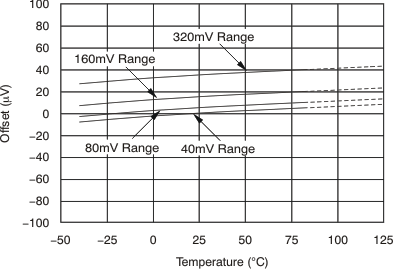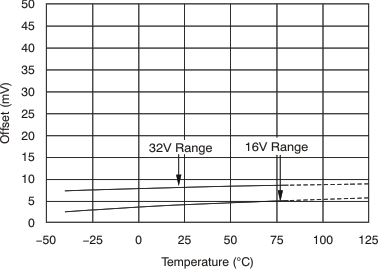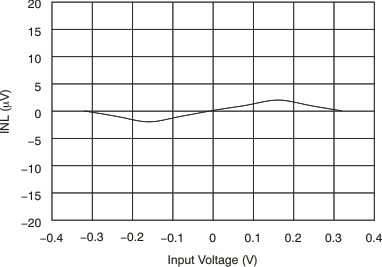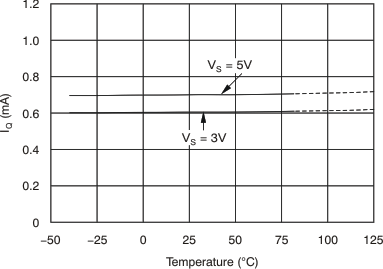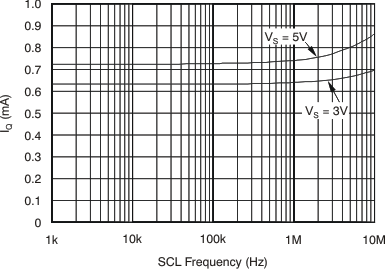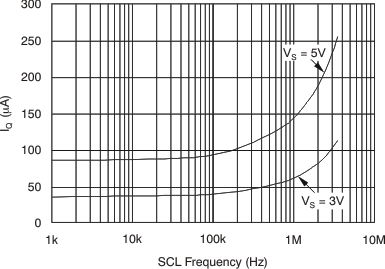ZHCS951B June 2012 – March 2016 INA220-Q1
PRODUCTION DATA.
- 1 特性
- 2 应用
- 3 说明
- 4 修订历史记录
- 5 Related Products
- 6 Pin Configuration and Functions
- 7 Specifications
-
8 Detailed Description
- 8.1 Overview
- 8.2 Functional Block Diagram
- 8.3 Feature Description
- 8.4 Device Functional Modes
- 8.5 Programming
- 8.6 Register Maps
- 9 Application and Implementation
- 10Power Supply Recommendations
- 11Layout
- 12器件和文档支持
- 13机械、封装和可订购信息
7 Specifications
7.1 Absolute Maximum Ratings
over operating free-air temperature range (unless otherwise noted)(1)| MIN | MAX | UNIT | |||
|---|---|---|---|---|---|
| VS | Supply voltage | 6 | V | ||
| Analog inputs IN+, IN– |
Differential (VIN+) – (VIN–)(2) | –26 | 26 | V | |
| Common-mode (VIN+ + VIN-) / 2 | –0.3 | 26 | V | ||
| VVBUS | Voltage at VBUS pin | –0.3 | 26 | V | |
| VSDA | Voltage at SDA pin | GND – 0.3 | 6 | V | |
| VSCL | Voltage at SCL pin | GND – 0.3 | VS + 0.3 | V | |
| Input current into any pin | 5 | mA | |||
| Open-drain digital output current | 10 | mA | |||
| Operating temperature | –40 | 125 | °C | ||
| TJ | Junction temperature | 150 | °C | ||
| Tstg | Storage temperature | –65 | 150 | °C | |
(1) Stresses beyond those listed under Absolute Maximum Ratings may cause permanent damage to the device. These are stress ratings only, which do not imply functional operation of the device at these or any other conditions beyond those indicated under Recommended Operating Conditions. Exposure to absolute-maximum-rated conditions for extended periods may affect device reliability.
(2) IN+ and IN– may have a differential voltage of –26 to 26 V; however, the voltage at these pins must not exceed the range of –0.3 to 26 V.
7.2 ESD Ratings
| VALUE | UNIT | ||||
|---|---|---|---|---|---|
| V(ESD) | Electrostatic discharge | Human-body model (HBM), per AEC Q100-002(1) | ±2000 | V | |
| Charged-device model (CDM), per AEC Q100-011 | ±750 | V | |||
(1) AEC Q100-002 indicates that HBM stressing shall be in accordance with the ANSI/ESDA/JEDEC JS-001 specification.
7.3 Recommended Operating Conditions
over operating free-air temperature range (unless otherwise noted)| MIN | NOM | MAX | UNIT | ||
|---|---|---|---|---|---|
| VCM | (VIN+ + VIN-) / 2 | 12 | V | ||
| VS | Supply voltage | 3.3 | V | ||
| TA | Ambient temperature | –25 | 85 | ºC | |
7.4 Thermal Information
| THERMAL METRIC(1) | INA220-Q1 | UNIT | |
|---|---|---|---|
| DGS (10 PINS) | |||
| RθJA | Junction-to-ambient thermal resistance | 165.4 | °C/W |
| RθJC(top) | Junction-to-case (top) thermal resistance | 53.2 | °C/W |
| RθJB | Junction-to-board thermal resistance | 86.6 | °C/W |
| ψJT | Junction-to-top characterization parameter | 6.4 | °C/W |
| ψJB | Junction-to-board characterization parameter | 85 | °C/W |
(1) For more information about traditional and new thermal metrics, see the Semiconductor and IC Package Thermal Metrics application report, SPRA953.
7.5 Electrical Characteristics
at TA = 25°C, VS = 3.3 V, VIN+ = 12 V, VSHUNT = (VIN+ – VIN–) = 32 mV, VVBUS = 12 V, PGA = /1, and BRNG(1) = 1, unless otherwise noted.| PARAMETER | TEST CONDITIONS | MIN | TYP | MAX | UNIT | |
|---|---|---|---|---|---|---|
| INPUT | ||||||
| VSHUNT | Full-scale current sense (input) voltage range | PGA = /1 | 0 | ±40 | mV | |
| PGA = /2 | 0 | ±80 | mV | |||
| PGA = /4 | 0 | ±160 | mV | |||
| PGA = /8 | 0 | ±320 | mV | |||
| Bus voltage (input voltage)(2) | BRNG = 1 | 0 | 32 | V | ||
| BRNG = 0 | 0 | 16 | V | |||
| Common-mode rejection | VIN+ = 0 to 26 V | 100 | 120 | dB | ||
| VOS | Offset voltage, RTI(3) | PGA = /1 | ±10 | ±50 | μV | |
| PGA = /2 | ±20 | ±75 | μV | |||
| PGA = /4 | ±30 | ±75 | μV | |||
| PGA = /8 | ±40 | ±100 | μV | |||
| TA = –40°C to 85°C | 0.16 | μV/°C | ||||
| PSRR | Offset voltage versus power supply, RTI(3) | VS = 3 to 5.5 V | 10 | μV/V | ||
| Current sense gain error | ±40 | m% | ||||
| TA = –40°C to 85°C | 1 | m%/°C | ||||
| IIN+, IIN– | Input bias current at IN+ and IN– | Active mode | 20 | μA | ||
| VBUS pin input impedance(5) | Active mode | 320 | kΩ | |||
| IN+ pin input leakage(4) | Power-down mode | 0.1 | ±0.5 | μA | ||
| IN– pin input leakage(4) | Power-down mode | 0.1 | ±0.5 | μA | ||
| DC ACCURACY | ||||||
| ADC basic resolution | 12 | bits | ||||
| Shunt voltage | 1-LSB step size | 10 | μV | |||
| Bus voltage | 1-LSB step size | 4 | mV | |||
| Current measurement error | ±0.2% | ±0.3% | ||||
| TA = –40°C to 85°C | ±0.5% | |||||
| Bus voltage measurement error | VBUS = 12 V | ±0.2% | ±0.5% | |||
| TA = –40°C to 85°C | ±1% | |||||
| Differential nonlinearity | ±0.1 | LSB | ||||
| ADC TIMING | ||||||
| ADC conversion time | 12-bit | 532 | 586 | μs | ||
| 11-bit | 276 | 304 | μs | |||
| 10-bit | 148 | 163 | μs | |||
| 9-bit | 84 | 93 | μs | |||
| Minimum convert input low time | 4 | μs | ||||
| SMBus | ||||||
| SMBus timeout(6) | 28 | 35 | ms | |||
| DIGITAL INPUTS (SDA as Input, SCL, A0, A1) | ||||||
| Input capacitance | 3 | pF | ||||
| Leakage input current | 0 ≤ VIN ≤ VS | 0.1 | 1 | μA | ||
| VIH | Input logic-level high | 0.7 (VS) | 6 | V | ||
| VIL | Input logic-level low | –0.3 | 0.3 (VS) | V | ||
| Hysteresis | 500 | mV | ||||
| OPEN-DRAIN DIGITAL OUTPUTS (SDA) | ||||||
| Logic 0 output level | ISINK = 3 mA | 0.15 | 0.4 | V | ||
| High-level output leakage current | VOUT = VS | 0.1 | 1 | μA | ||
| POWER SUPPLY | ||||||
| Operating supply range | 3 | 5.5 | V | |||
| Quiescent current | 0.7 | 1 | mA | |||
| Quiescent current, power-down mode | 6 | 15 | μA | |||
| Power-on reset threshold | 2 | V | ||||
(1) BRNG is bit 13 of the Configuration Register 00h (see Figure 19).
(2) This parameter only expresses the full-scale range of the ADC scaling. In no event should more than 26 V be applied to this device.
(3) Referred-to-input (RTI)
(4) Input leakage is positive (current flowing into the pin) for the conditions shown at the top of the table. Negative leakage currents can occur under different input conditions.
(5) The input impedance of this pin may vary approximately ±15%.
(6) SMBus timeout in the INA220-Q1 resets the interface any time SCL or SDA is low for more than 28 ms.
7.6 Typical Characteristics
at TA = 25°C, VS = 3.3 V, VIN+ = 12 V, VSHUNT = (VIN+ – VIN–) = 32 mV, PGA = /1, and BRNG = 1, unless otherwise noted.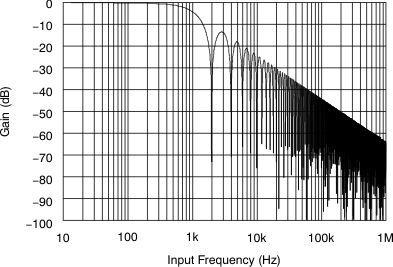
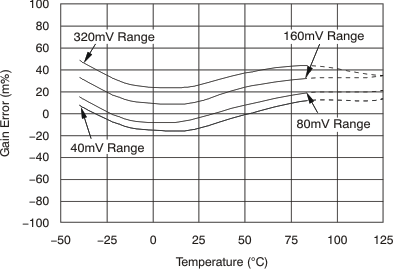
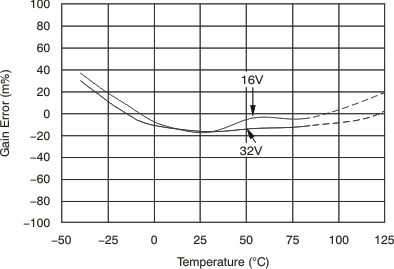
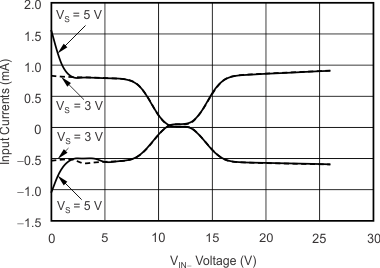
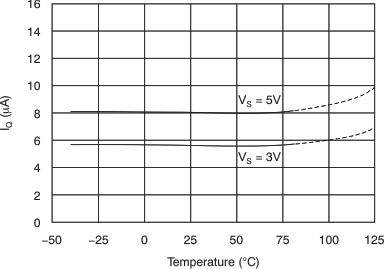
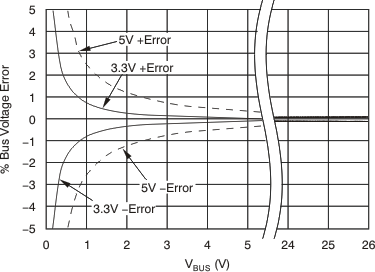
vs Supply Voltage
